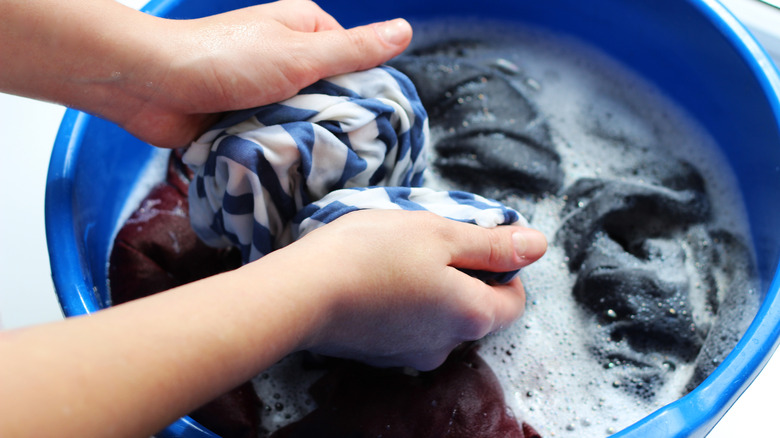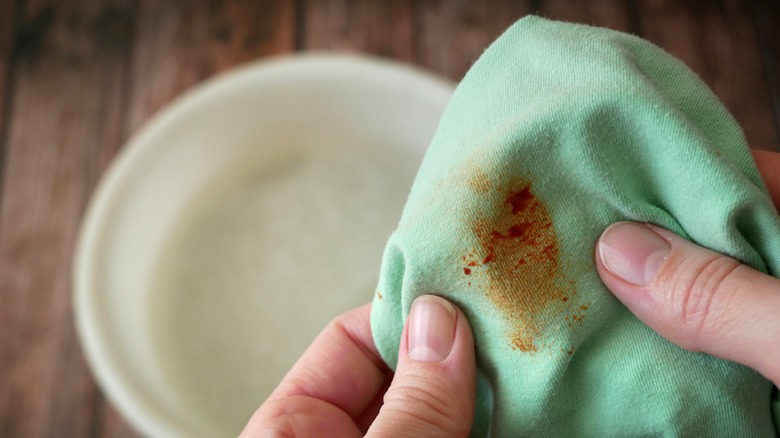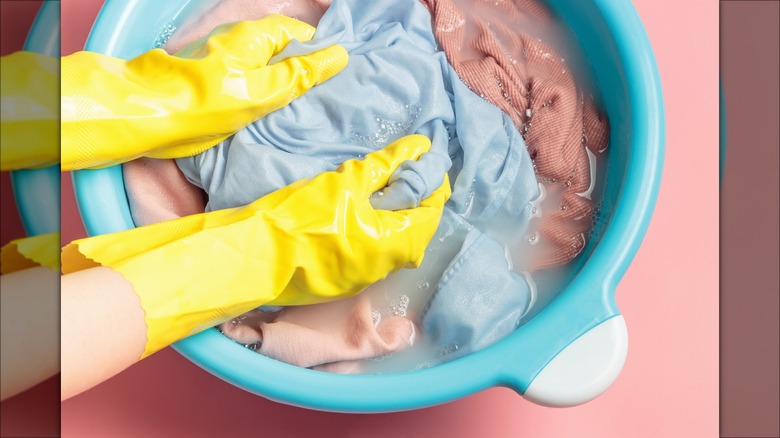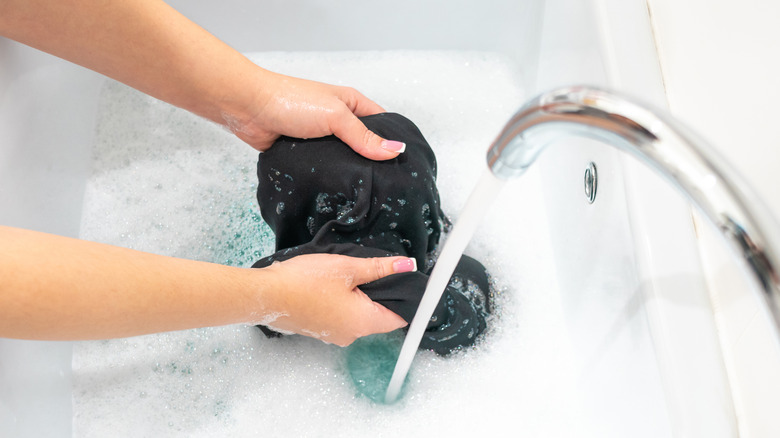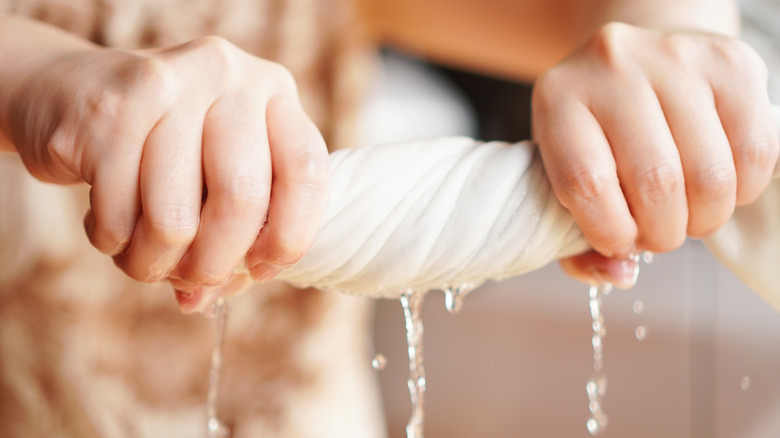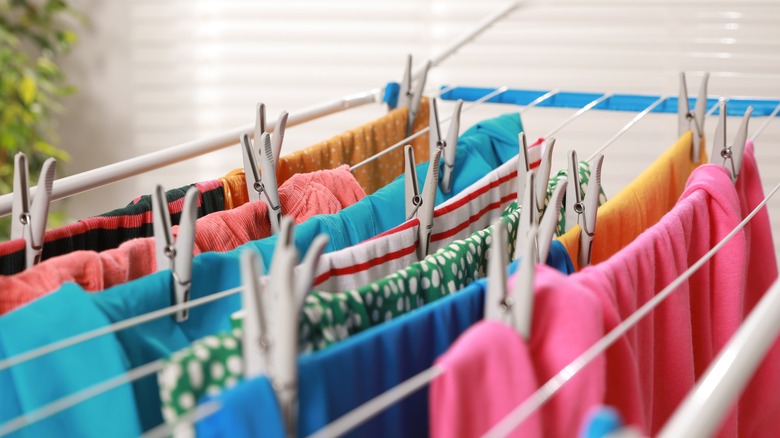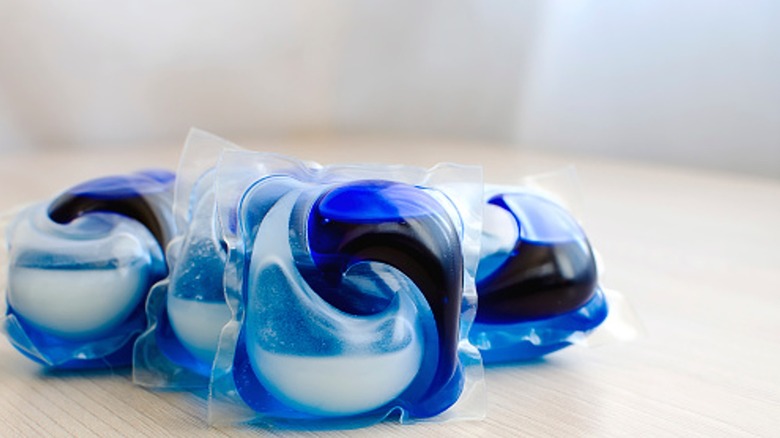The Biggest Mistakes To Avoid When Hand-Washing Your Laundry
Laundry can seem like a never-ending chore. You wash one load, and then, almost instantly, there is another pile of dirty clothes or linens that need to be cleaned. When you add in the task of hand-washing delicates or other items, either because the manufacturer recommends doing so or because you don't have a washer or yours is on the fritz, the chore can become even more challenging and time-consuming. What you don't want to do, however, is inadvertently make a mistake when hand-washing your clothing.
Unfortunately, mistakes with hand-washing laundry are quite common, either because individuals haven't been properly taught how to use this cleaning method or because they are rushing and trying to save time. Regardless of the reason for the mistake, improperly hand-washing your laundry has the potential to ruin your items. You could end up damaging the fabric, altering its color, or allowing stains to set in. Read on to learn how you can avoid these common mistakes to ensure your clothing and linens maintain their quality and appearance after being hand-washed.
Not pre-treating for stains before washing the clothes
Sure, pre-treating laundry stains before hand-washing a load increases the amount of time the chore will take. However, failing to pre-treat stains is a mistake you don't want to make. Skipping this important step often means that the stain will not come out with just the standard hand-washing process. Not only will your garment not come out looking clean, the stain could become set into the fabric, making it even more difficult — if not impossible — to remove.
Instead of overlooking this step, inspect all of your garments and linens before hand-washing them. Pre-treat any stains using a color-safe stain remover. Follow the directions on the product to let the spray sit for a few minutes. Then, gently scrub it using a laundry brush. The scrubbing motion coupled with the stain remover should help break down the stain, lifting it from the item. To finish the stain-removal process, soak the affected garment or linen in a tub of lukewarm water for about half an hour. This will ensure maximum penetration of the stain removal to make sure the stain disappears after washing.
Forgetting to wash different colors separately
You wouldn't toss a red shirt into the washing machine with a load of whites, would you? Well, doing so when hand-washing your laundry would also be a mistake. Failing to separate whites and colors when hand-washing clothing can result in the dyes from the darker fabrics bleeding into the lighter fabrics. Even if it isn't as extreme as the age-old example of turning a white t-shirt pink, at a minimum, your lights are going to start looking discolored and dingy, especially after a few washes.
Even though it means a bit more work for you, take the time to separate your items by color. If you want to be able to reuse the sudsy water for a second load, be sure to wash the lighter-colored loads first. Beyond sorting items by color, it is also advisable to separate fabric types. For example, washing a pair of jeans with a silk blouse, even if they're about the same color, is not a good idea. If the rough fabric of the jeans rubs against the more delicate silk, it is likely to damage it.
Rinsing the laundry under the faucet
After agitating the water and letting the laundry soak in the tub or basin, it is time to rinse the detergent off. To do so, you should simply turn on the faucet, hold the items under the running water, and be done with it, right? Wrong. While this may seem like the easiest way to get rid of the suds, it is far from the best approach. The force of the running water will push against your fabrics, potentially stretching them out. This can potentially ruin one of your favorite garments, so it definitely isn't worth it to try to save a few minutes.
Instead, remove the soapy garments, drain the basin, refill it with clean, cool water, and gently pull the clothing items back through the water to rinse away the soap. Repeat these steps of draining and refilling the basin a few times until no suds remain in the water.
Wringing the clothes to dry them
Now that you've rinsed the suds away, you'll need to remove the excess water from garments or linens you just washed. Do not make the mistake of wringing them out. While this can be an effective method for extracting water, it is also going to have an adverse effect on the fabric. Wringing involves tightly twisting the fabric, which will stretch it out. As the material stretches, it could also become thinner and more likely to become damaged.
To dry delicate laundry without wringing out the excess water, grab a towel. Lay the towel out flat and place the clothing item on top of it. Then, simply roll the towel up and gently press down on it. Doing so will extract water from the garment without stretching it out. You shouldn't expect the clothing items to be fully dry, but you want them to be only slightly damp. If necessary, repeat the steps above a few additional times if they are still too wet.
Not drying the clothes properly
One of the main reasons you're likely choosing to hand-wash a load of laundry is to protect the fabrics from being damaged in the washing machine. Don't undo all the effort you put into cleaning the load only to damage the items by drying them improperly. It should probably go without saying, but avoid using the dryer. Doing so could cause delicate fabrics to stretch, tear, or snag. More surprising, perhaps, is that many items should not be hung to dry. Sweaters, for example, are very heavy when wet. If you hang a sweater up to dry, the weight of the fabric is going to stretch out the material. The damage can be even more pronounced if you hang the sweater on a wire hanger, as it may leave imprints around the shoulder areas.
The best, and safest, approach is to lay your laundry flat to dry. You may even notice that some manufacturers specifically recommend laying their garments flat on the care tags. Drying flat is best because gravity isn't pulling heavy and wet fabrics down, causing the item to become stretched out. Be thoughtful about where you lay your items out to dry. Avoid any locations that are in direct sun or direct heat (such as from the dryer). Too much heat or direct sunlight could also damage the fabrics.
Using hot water to wash delicates
Do not, we repeat, do not use hot water when hand-washing your delicates. While you may reason that hot water will do a better job of removing dirt and grime from your clothing, it can also be detrimental to the fabrics. Using hot water can shrink your items, rendering them useless. Before you opt for warm water instead, know that it too can be problematic. While the shrinkage may not be immediate, as it could be with hot water, repeatedly washing a garment in warm water can cause it to shrink over time.
For delicate and any other garments that the manufacturer does not specifically recommend washing in hot water, stick with cold water. Cold water is much gentler, and you won't need to worry about it causing your clothing to shrink. It is also more eco-friendly as you don't need to consume extra energy to heat the water.
Using laundry pods
Laundry pods come in handy when cleaning a load of laundry in the washer. However, some people incorrectly assume that they can also be used for hand-washing clothing and linens too. Unfortunately, using laundry pods to hand-wash clothing is a big mistake for a number of reasons. First, the detergent in the pod is very concentrated. So, while it may not look like too much for a small load of hand-washing, it is. Each pod is designed to be used with a washing machine full of clothes and water, not a basin with a small amount of water and just a few items. Using too much detergent could end up causing damage to your fabrics. Moreover, the American College of Medical Toxicology explains that the concentrated detergent can irritate the skin or eyes, potentially resulting in chemical burns.
Stick with a gentle detergent or mild dish soap when hand-washing linens or garments. If you like the convenience of laundry pods, save them for the next load you plan to run through the washing machine.
